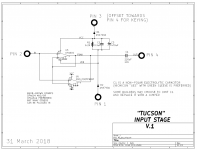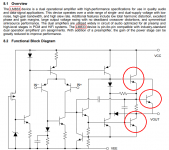My samples arrived today FEDEX 3 days after requesting them, USA to the UK. SUPERB.
The paper spec is no more than a talking point, what really matters is the chip in actual use. We can only comment on that with experience of use. I'll post on that subject when I have had time to use and listen to the device.
The paper spec is no more than a talking point, what really matters is the chip in actual use. We can only comment on that with experience of use. I'll post on that subject when I have had time to use and listen to the device.
Any updates to all these discussions?
It has been a few months and folks should have been able to develop thoughts and opinions by now. I am considering the 1611/1612 in a preamp and would like as much info as I can get. Thanks.
It has been a few months and folks should have been able to develop thoughts and opinions by now. I am considering the 1611/1612 in a preamp and would like as much info as I can get. Thanks.
Just tried a pair of OPA1611 in a fully differential head amp. Did some very significant A/B listening tests against other known-good devices. Wasn't bad, but there are far better devices for the task.
A few of us have built the "Tucson" interchangeable daughter board for the First Watt M2x power amp, using the OPA1611, the OPA604, and the LT1122. The circuit design is ultra simple (figure below).
So far the early consensus seems to be that Tucson-with-LT1122 sounds better than the other two. For what it's worth.
edit- oh by the way, LT1122 is available in PDIP-8 and also SOIC-8, if that's the sort of thing that matters to you.
_
So far the early consensus seems to be that Tucson-with-LT1122 sounds better than the other two. For what it's worth.
edit- oh by the way, LT1122 is available in PDIP-8 and also SOIC-8, if that's the sort of thing that matters to you.
_
Attachments
Last edited:
A few of us have built the "Tucson" interchangeable daughter board for the First Watt M2x power amp, using the OPA1611, the OPA604, and the LT1122. The circuit design is ultra simple (figure below).
So far the early consensus seems to be that Tucson-with-LT1122 sounds better than the other two. For what it's worth.
_
Very likely this is because the LT1122 op amps happened to be better “matched”. Otherwise, putting two op amps in parallel without any output ballast resistors is in general considered a very bad idea.
No. There are two symbols on the schematic because there are two footprints on the PCB. However the board assembler either populates the DIP footprint, or the SOIC footprint, but not both at the same time. Should you wish to purchase large numbers of blank Tucson boards for experimenting with large numbers of different, non-socketed SOICs, this might be one place to look.
FS: M2x daughter cards, type "TUCSON"
edit- or lay out and fab them yourself, the interchangeable cards are simple and well documented in the M2x amplifier's discussion thread
FS: M2x daughter cards, type "TUCSON"
edit- or lay out and fab them yourself, the interchangeable cards are simple and well documented in the M2x amplifier's discussion thread
Last edited:
No. There are two symbols on the schematic because there are two footprints on the PCB. However you either populate the DIP footprint, or the SOIC footprint, but not both at the same time. Should you wish to purchase large numbers of blank Tucson boards for experimenting with large numbers of different, non-socketed SOICs, this might be one place to look.
FS: M2x daughter cards, type "TUCSON"
Ok, so electrically speaking the Tucson thing is a simple op amp unity gain buffer. Then I see absolutely no support for the LT1122 “sounds better” claim.
Thanks, but I can build an op amp unity gain buffer myself, if I would need one. I got a bunch of SOIC to PDIP adapters with power supply decouplings for 15 cents a pop.
So far, of the people who have built and listened to the simple unity gain buffer made with 3 different opamps, all have preferred the sound of one particular opamp.
It's just anecdotal data; people reporting their personal experience listening to music on homemade gear.
The surprise, if any, might be: that there was any preference at all.
Perhaps a second, smaller, surprise might be: that the preferred sound didn't come out of the whiz-bang slick OPA1611 and its SiGe pedigree.
It's just anecdotal data; people reporting their personal experience listening to music on homemade gear.
The surprise, if any, might be: that there was any preference at all.
Perhaps a second, smaller, surprise might be: that the preferred sound didn't come out of the whiz-bang slick OPA1611 and its SiGe pedigree.
The surprise, if any, might be: that there was any preference at all.
Not at all; I would not expect from humans engaging in the effort to do such an evaluation to end up having no preference. That would be, from a psychological perspective, equivalent to a failure or waste of time, not easy to accept for many.
Why people preferred the LT1122 in this particular test run can also be easily explained from a psychoacoustic perspective, but I won’t get into that.
So far, of the people who have built and listened to the simple unity gain buffer made with 3 different opamps, all have preferred the sound of one particular opamp.
It's just anecdotal data; people reporting their personal experience listening to music on homemade gear.
The surprise, if any, might be: that there was any preference at all.
Perhaps a second, smaller, surprise might be: that the preferred sound didn't come out of the whiz-bang slick OPA1611 and its SiGe pedigree.
Only test instruments can tell them apart really, unless pushed to the noise floor in which case the relatively poor current noise of the OPA1611 would show up at high impedances, as would the relatively poor voltage noise of the LT1122 (showing up at low circuit impedances). Don't use the OPA1611 for a MM phono preamp, don't use the LT1122 for an MC or microphone preamp.... At line level its academic, the post important spec is the price!
Will compare, from a listening perspective, with LM4562 .
I didn't realize that this thread started 10+ years ago, the wheels of justice grind slowly but infinitely fine...
I didn't realize that this thread started 10+ years ago, the wheels of justice grind slowly but infinitely fine...
Jack, I think it would be a good project to lay out a little adapter board which allows an SOIC-8 packaged, dual opamp like the LM4562, to be plugged into a DIP-8 socket for a single opamp like the OPA1611.
There are a few duals that I'd like to try out this way, including LM4562, OPA1656, and (ahem) LM833DGKR, the one not designed by NSC, the one with the all-NPN output stage. NSC's version had a complementary follower output with NPN+PNP.
Mark
_
There are a few duals that I'd like to try out this way, including LM4562, OPA1656, and (ahem) LM833DGKR, the one not designed by NSC, the one with the all-NPN output stage. NSC's version had a complementary follower output with NPN+PNP.
Mark
_
Attachments
There are a few duals that I'd like to try out this way, including LM4562, OPA1656, and (ahem) LM833DGKR, the one not designed by NSC,
_
I think I used LM833 in my first phono-preamp.
We can do a bake-off at my son's place in Glen Ellen if you don't mind being run over by toddlers.
FYI, as I found out reading the OPA1656 datasheet, TI is selling
http://www.ti.com/tool/DIP-ADAPTER-EVM
I bought one in my last Digi-Key order but Mouser has them too
595-DIP-ADAPTER-EVM
I have not looked at it close enough to determine if they covered this case
http://www.ti.com/tool/DIP-ADAPTER-EVM
I bought one in my last Digi-Key order but Mouser has them too
595-DIP-ADAPTER-EVM
I have not looked at it close enough to determine if they covered this case
dual opamp like the LM4562, to be plugged into a DIP-8 socket for a single opamp like the OPA1611.
Last edited:
- Home
- Amplifiers
- Solid State
- Burr-Brown OPA1611/1612 are here

